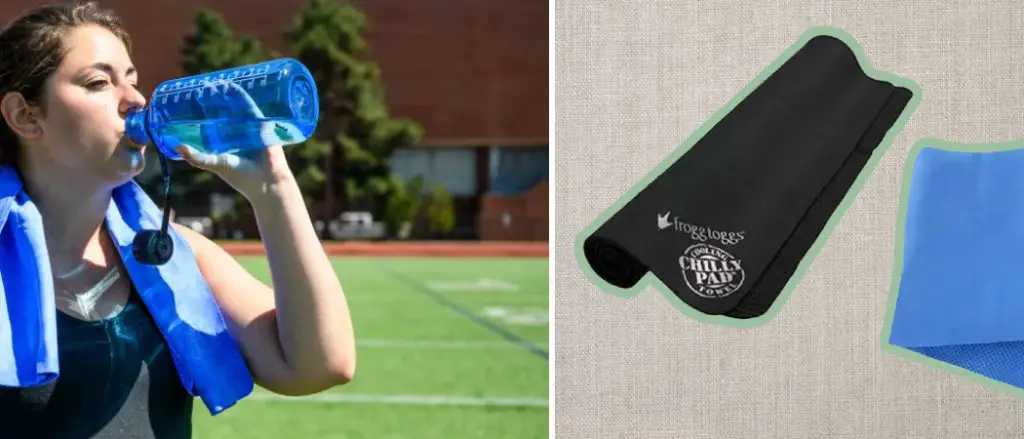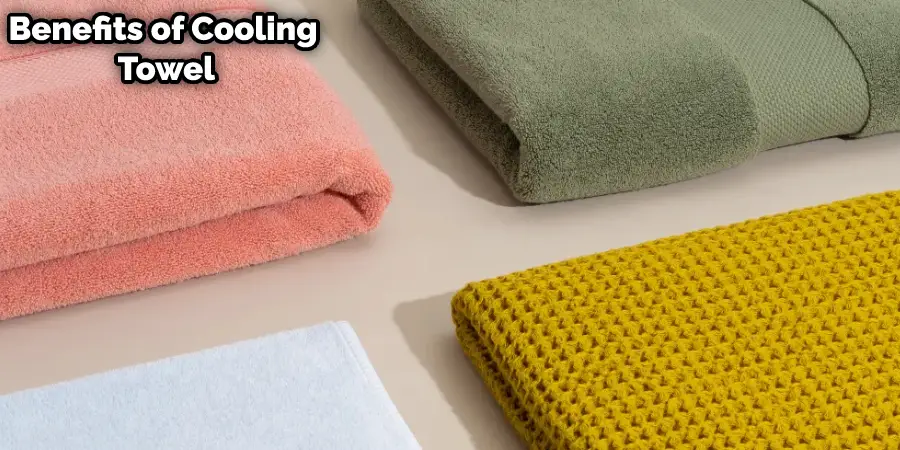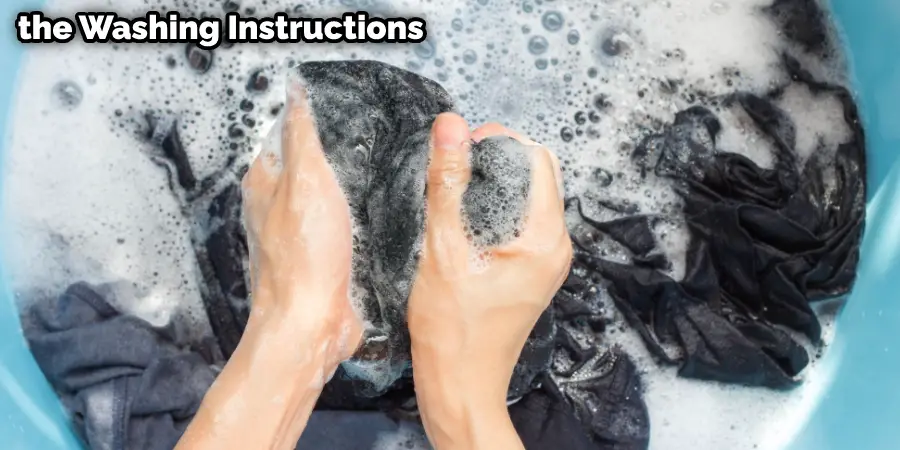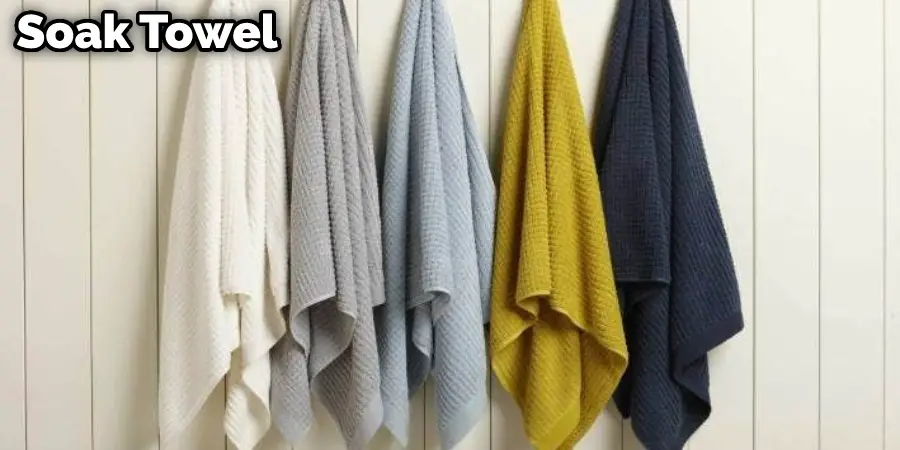Are you looking for an easy and convenient way to cool down after a hot day outdoors or when you’re working up a sweat inside? Then cooling towels are the perfect fit! Not only do they offer a refreshing coolness in a pinch, but with the right care, they can last for years.

In this blog post, we’re here to guide you through exactly how to properly clean and maintain your cooling towel so that it will remain soft and refreshed throughout its lifetime. You don’t have to worry about taking extra time out of your hectic schedule to keep your cooling towel pristine — this post has all of the tips and tricks necessary for keeping your fabric feeling fresh without spending too much effort! Let’s get started to learn more about how to wash cooling towels.
Benefits of Cooling Towel
Cooling towels offer several benefits, especially in hot weather or during physical activities. Here are some of the advantages of using cooling towels:
Temperature Regulation
Cooling towels are specifically designed to help regulate body temperature. When wetted and then draped around your neck, head, or other body parts, they provide a cooling effect that helps lower your body temperature, providing relief from the heat and promoting comfort.
Heat Stress Prevention
Cooling towels are particularly beneficial in hot and humid environments or during intense physical activities. They can help prevent heat-related illnesses, such as heat stroke or heat exhaustion, by controlling your body temperature and minimizing the risk of overheating.
Instant Cooling Sensation
One of the key advantages of cooling towels is their ability to provide instant relief. The cooling effect is activated as soon as the towel is wetted and snapped or wrung out. This quick cooling sensation can be refreshing, especially when you’re feeling hot and sweaty.
Versatility
Cooling towels are versatile in their usage. They can be used during various activities, including sports, workouts, outdoor adventures, or simply for everyday cooling. They are lightweight and portable, making them easy to carry in a bag or pocket.
Reusability
Most cooling towels are reusable, which makes them cost-effective and environmentally friendly. After use, you can wash and dry them for future use, allowing you to enjoy their cooling benefits repeatedly.
Absorbency
Cooling towels are often made from materials that have high absorbency, such as microfiber or synthetic blends. They can effectively absorb moisture, sweat, and excess heat from your body, helping you stay dry and comfortable.
UV Protection
Some cooling towels also offer UV protection. They can act as a barrier between your skin and the sun’s harmful ultraviolet (UV) rays, reducing the risk of sunburn and providing an additional layer of sun protection.

Remember that while cooling towels provide relief from the heat, they are not a substitute for proper hydration and other heat safety measures. Staying hydrated, taking breaks in shaded areas, and following appropriate heat safety guidelines when exposed to high temperatures are essential.
Understand the Washing Instructions
Understanding the washing instructions provided by the manufacturer is crucial when it comes to caring for your cooling towels. Here’s why it’s important to read and follow these guidelines:
Material Variations
Cooling towels are made from different materials, such as microfiber, synthetic blends, or specialized fabrics. Each material may have specific care requirements to maintain its quality and functionality. Manufacturers understand their product materials best and provide washing instructions tailored to them.
Construction and Features
Cooling towels often have unique features or construction techniques that contribute to their cooling properties. For example, some towels may contain specialized cooling gels or technologies. Following the manufacturer’s washing instructions ensures that these features are preserved and not compromised during cleaning.
Durability and Longevity
Cooling towels are designed to withstand repeated use, but improper washing can affect their durability and lifespan. Adhering to the manufacturer’s instructions can help maintain the towel’s integrity, preventing premature wear, color fading, or loss of cooling effectiveness.
Product Safety
Manufacturers may provide specific washing instructions to ensure the user’s safety. Some towels may require particular care to avoid skin irritation, chemical reactions, or damage to the fabric. Following the guidelines can minimize any potential risks associated with improper washing.
Performance Optimization
Cooling towels are meant to provide optimal cooling and comfort. The manufacturer’s instructions may include steps that help maintain the towel’s cooling properties, such as avoiding certain detergents or washing at specific temperatures. By following these guidelines, you can ensure that the towel continues to deliver the desired cooling effect.
Warranty Considerations
Some cooling towels come with warranties or guarantees. Deviating from the recommended washing instructions may void these warranties. By following the guidelines, you can retain the benefits of any warranty coverage and seek assistance from the manufacturer if needed.

In summary, different brands and materials used in cooling towels may have unique characteristics and requirements. By reading and following the manufacturer’s washing instructions, you can maintain the towel’s quality, functionality, and longevity while ensuring user safety. It’s essential to prioritize the specific guidelines provided to optimize the performance of your cooling towel.
How to Wash Cooling Towels with a Washing Machine
Step 1: Check the Label
Before you start washing your cooling towel, check the label for any special instructions or information. Note any designated temperature settings, detergent types, and other care requirements suggested by the manufacturer.
Step 2: Prepare Your Towel
If you plan to hand-wash your cooling towel, skip this step. Otherwise, prepare your towel for machine washing. Start by closing any velcro fasteners, zippers, or buttons on the towel. This will prevent them from snagging during the wash cycle.
Step 3: Load into the Machine
Carefully load your cooling towel into the washing machine, not overloading it. Ensure that there is enough space between the towel and other clothes for proper circulation of water and detergent.
Step 4: Select Settings
Set the washing machine to the designated temperature and cycle length as per the manufacturer’s instructions. If necessary, select any special features, such as a gentle cycle or cool rinse.
Step 5: Add Detergent
Add the recommended detergent to the machine before starting the cycle. Liquid or powdered detergents work best for cooling towels since they can be easily rinsed off.
Step 6: Start Machine
Once everything is set, press the “Start” button and let the washing machine do its job. Check regularly to ensure that the cycle is running without any problems.
Step 7: Remove the Towel
Once the cycle has finished, carefully remove your cooling towel from the washing machine. Hang it up or lay it flat to air-dry. Do not put it in a dryer, which can damage the fabric and reduce effectiveness.
How to Wash Cooling Towels by Hand
Step 1: Prepare Your Towel
Before you start washing your cooling towel, check the label for any special instructions or information. Close any velcro fasteners, zippers, or buttons on the towel to prevent them from snagging during the wash cycle.
Step 2: Fill a Basin
Fill a basin with cool water and add a bit of mild detergent to it. Ensure that the basin is large enough to fit your cooling towel without crowding it.
Step 3: Soak Towel
Submerge your cooling towel in the soapy water and let it soak for several minutes. Use a soft brush or sponge to scrub any dirt or grime from the fabric gently.

Step 4: Rinse the Towel
Once you are done scrubbing, rinse your cooling towel in cool, clean water until all the soap is removed. Gently squeeze out any excess water and let it air dry.
Step 5: Dry Towel
Hang up or lay your cooling towel flat to air-dry. Do not put it in a dryer, which can damage the fabric and reduce effectiveness.
How to Dry and Store Cooling Towels
Step 1: Air-Dry Towel
Once you have washed your cooling towel, hang it up or lay it flat to air-dry. Do not put it in a dryer, which can damage the fabric and reduce effectiveness.
Step 2: Fold Towel Properly
When your cooling towel is completely dry, carefully fold it and put it away for storage. Folding the towel properly will help maintain its quality and reduce wrinkling.
Step 3: Store in a Cool Place
Store your cooling towel in a cool, dry place when not in use. Avoid leaving it exposed to direct sunlight or heat sources, which can damage the fabric and reduce its effectiveness.
Step 4: Refresh Towel Periodically
To keep your cooling towel in good condition, you should refresh it periodically by washing it as described above. This will help extend its lifespan and increase its cooling capabilities.
Follow these simple steps to clean, dry, and store your cooling towel properly and ensure that it lasts longer. With the right care, your cooling towel can keep you feeling cool and comfortable for years to come.
Common Concerns and Potential Issues Related to Cooling Towels and Their Solutions
1. Color Bleeding and Its Solution
Color bleeding is a common issue with cooling towels, especially if they are not washed properly. To prevent this, wash your towel separately from other clothes and avoid using hot water. If the colors still bleed, try using color-safe detergents or special fabric spot-cleaners.
2. Shrinking and Its Solution
Shrinking is another common issue with cooling towels, especially if they are not dried properly. To prevent this, make sure to air-dry the towel instead of putting it in a dryer. If the towel still shrinks, try stretching it out gently when wet and reshaping it while drying.
3. Odor and Its Solution
Sometimes cooling towels start to smell after multiple uses. To prevent this, make sure to wash your towel regularly and avoid leaving it in a damp environment. If the odor persists, try using odor-eliminating agents or soaking the towel in distilled vinegar before washing.
4. Texture or Fabric Changes and Their Solution
Over time, the texture and fabric of a cooling towel may change due to wear and tear. To prevent this, make sure to follow all washing instructions carefully and store the towel in a cool, dry place. If the fabric starts to thin or fray, it is best to replace your towel with a new one.
Taking good care of your cooling towel can help it last longer and keep you feeling cool and comfortable. With the right cleaning techniques and storage tips, you can ensure that your cooling towel is always ready for use.
What to Do if Your Cooling Towel Is Stained or Smelly
If you’ve been using your cooling towel regularly, it’s inevitable that it will eventually get stained or develop an unpleasant smell. But don’t worry – there are simple solutions for dealing with both of these issues.
Removing Stains
To remove stains from your cooling towel, start by soaking it in a solution of warm water and mild detergent for 15-20 minutes. Then, gently scrub the stained area with a soft-bristled brush or sponge. Rinse the towel thoroughly and repeat this process if necessary.
For tougher stains, you can also add a small amount of white vinegar to the soaking solution or use a stain remover product specifically designed for athletic gear. Just be sure to always read and follow the instructions on any cleaning products you use.
Dealing with Odors
If your cooling towel has developed an unpleasant smell, the first step is to wash it as described above. However, for a more thorough cleaning and odor removal, you can also try soaking the towel in a mixture of warm water and baking soda for 30 minutes before washing.
Another effective method for eliminating odors from your cooling towel is to use white vinegar. Add 1/2 cup of white vinegar to the washing machine along with your detergent and wash as usual.
Proper Drying Techniques
Once you’ve successfully removed any stains or odors from your cooling towel, it’s important to dry it properly. This will not only help prevent any lingering smells but also keep the towel in good condition for future use.
The best way to dry a cooling towel is to lay it flat on a clean surface, such as a drying rack or towel bar. Avoid using direct heat from sources such as the sun or a dryer, as this can damage the fabric and decrease its cooling abilities.
If you need your towel to dry quickly, you can also gently wring out any excess water and then hang it up to air dry. Just be sure to avoid wringing too hard, as this can also damage the fabric.
Additional Tips for Maintaining Your Cooling Towel
To keep your cooling towel in top condition, there are a few additional tips you can follow:
- Always wash your cooling towel after each use to prevent bacteria growth.
- Avoid using fabric softener, bleach, or harsh chemicals when cleaning your towel.
- If you notice any tears or fraying in the fabric, repair them immediately to prevent further damage.
By following these tips and properly caring for your cooling towel, you can ensure that it stays clean, fresh, and effective for all of your future uses. So don’t let stains or odors bring you down – with a little bit of cleaning and maintenance, your cooling towel will continue to provide you with relief from the heat for many more uses to come. So next time you’re feeling hot and sweaty, grab your trusty cooling towel and enjoy its refreshing benefits! Happy washing!
Additional Tips for Maximizing the Benefits of Your Cooling Towel
While washing and maintaining your cooling towel is important, there are also other ways to optimize its effectiveness and get the most out of your cooling experience. Here are a few suggestions:
- Before using your cooling towel, soak it in ice water for an extra boost of coolness.
- For added comfort, place your wet towel in the freezer for a couple of minutes before use.
- If you’ll be using your cooling towel for physical activities, consider getting a size larger than you normally would to ensure full coverage and maximum cooling.
- To increase the durability of your cooling towel, avoid wringing it out too hard or pulling on it too much when stretching it out after washing.
By following these tips and tricks, you can enhance the cooling benefits of your towel and make the most out of every use. So go ahead and enjoy your cooling towel to its fullest potential! Keep cool, stay hydrated, and have fun with your trusty cooling companion.
Conclusion
Washing a cooling towel can seem intimidating, but it doesn’t have to be. By following the simple steps outlined in this article and taking care not to put too much strain on your towel, you should be able to keep your cooling towels clean and fresh for many uses.
Remember that if you ever experience any issues with washing or cleaning a cooling towel, always refer back to the manufacturer’s instructions first. With proper use and maintenance, these towels will continue providing comfortable relief from hot temperatures for years to come! Thanks for reading this article about how to wash cooling towels.

